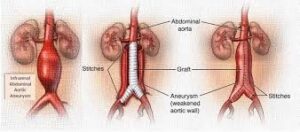Abdominal Aortic Aneurysm
Abdominal Aortic Aneurysm (AAA) manifests as an anomalous expansion or protrusion of the abdominal aorta, the principal conduit responsible for transporting oxygenated blood from the cardiac organ to the lower extremities (Rahim; Shaw et al.). This particular condition presents a substantial peril to one’s well-being and has the potential to result in grave ramifications if not promptly addressed. In order to attain a more comprehensive comprehension of AAA, one must explore its intricate pathology, its intricate interplay with the realm of normal anatomy and physiology, the specific structures that it impacts, and the discernible signs and symptoms that it manifests.
In a pathological context, it is worth noting that AAA predominantly manifests as the debilitation and attenuation of the abdominal aorta’s structural integrity. The process of arterial weakening is frequently correlated with the accrual of atherosclerotic plaques along the endothelial layer of the artery (Rahim; Shaw et al.). Over time, the persistent force exerted by the circulatory system against this debilitated barrier leads to its dilation and subsequent development of an aneurysmal condition. The etiology of AAA is postulated to stem from a confluence of genetic predisposition and modifiable risk factors, notably smoking, hypertension, and a diet rich in cholesterol. Are you seeking help on your nursing assignment? Get in touch with us.
In customary anatomical and physiological knowledge, it is widely acknowledged that the abdominal aorta is a resilient and pliable conduit, effectively facilitating the conveyance of oxygen-rich blood to the lower appendages. The diameter of the said entity remains relatively constant throughout its longitudinal extent, exhibiting adaptability to the physiological requirements of the organism. Nevertheless, within the realm of AAA, the delicate equilibrium inherent in nature is perturbed, thereby instigating an atypical dilation of the aorta. While subject to variation, this dilation typically manifests with a diameter of 3 cm or greater, as corroborated by esteemed sources such as Johns Hopkins, Kumar et al., and Nhs Inform.
The anatomical framework that experiences the most pronounced impact due to AAA is, not unexpectedly, the abdominal aorta in its entirety. The localized debilitation of the arterial wall results in the expansion of the vessel at the specific site in question. The phenomenon of dilation may manifest at various points along the abdominal aorta. Yet, it is predominantly observed in the region situated inferior to the renal arteries and superior to the iliac arteries.
The manifestations and indications of AAA may exhibit variability contingent upon the dimensions and positioning of the aneurysmal dilation. Frequently, diminutive AAAs exhibit no discernible symptoms and remain undetected until fortuitously encountered during a customary medical evaluation or imaging procedure conducted for an unrelated ailment (Rahim; Shaw et al.). Nevertheless, as the aneurysm expands, it has the potential to exert significant pressure on adjacent anatomical structures, thereby precipitating a diverse array of clinical manifestations.
One of the distinctive indicators of an expanding AAA is the presence of a pulsatile mass in the abdominal region, discernible to a healthcare practitioner through palpation during a physical assessment. Additional prevalent indications encompass abdominal or lumbar discomfort, characterized by a dull or throbbing quality, with potential propagation towards the groin or flank (Johns Hopkins; Kumar et al.; Nhs Inform). This discomfort frequently manifests due to the aneurysm’s forceful compression inflicted upon adjacent tissues. In heightened severity, wherein an AAA is susceptible to rupture, individuals may encounter an abrupt and profound discomfort within the abdominal region or back, frequently characterized as a tearing or ripping sensation. This situation necessitates urgent medical attention, as an AAA rupture carries the potential for perilous consequences such as severe internal hemorrhaging and subsequent physiological shock. Moreover, it is worth noting that specific individuals afflicted with AAA may exhibit no symptoms until complications, such as the embolization of blood clots or aortic dissection. These complications may manifest with symptoms such as leg pain, numbness, or weakness.
In summary, it can be deduced that AAA is a pathological state that perturbs the customary physiological functioning of the abdominal aorta. The phenomenon at hand pertains to the debilitation and expansion of the aortic membrane, frequently instigated by atherosclerosis and factors that can be altered. The proper abdominal aorta is the principal anatomical structure that experiences the impact, resulting in an aneurysmal dilation. The manifestations and indications may exhibit a range of diversity, wherein specific individuals may persist without any discernible symptoms. In contrast, others may encounter discomfort in the abdominal or lumbar region, pulsating masses in the abdominal area, and, in more critical instances, symptoms of a grave nature that pose a threat to life, such as aortic rupture. The timely identification and effective control of AAA are paramount in mitigating the potentially lethal outcomes of this condition. Therefore, individuals who are at risk must undergo routine screening and adopt measures to modify their risk factors.
Works Cited
Johns Hopkins. “Abdominal Aortic Aneurysm.” Www.hopkinsmedicine.org, 2023, www.hopkinsmedicine.org/health/conditions-and-diseases/abdominal-aortic-aneurysm.
Kumar, Vinay, et al. “Robbins Essential Pathology: Robbins Essential Pathology E-Book.” Google Books, Elsevier Health Sciences, 2020.
Nhs Inform. “Abdominal Aortic Aneurysm (AAA) Symptoms and Treatments.” Nhsinform.scot, 2019, www.nhsinform.scot/illnesses-and-conditions/heart-and-blood-vessels/conditions/abdominal-aortic-aneurysm.
Rahim, Saum A. “Abdominal Aortic Aneurysm: Practice Essentials, Background, Anatomy.” Medscape.com, 9 Nov. 2019, emedicine.medscape.com/article/1979501-overview.
Shaw, Palma M., et al. “Abdominal Aortic Aneurysm (AAA).” PubMed, StatPearls Publishing, 2020, www.ncbi.nlm.nih.gov/books/NBK470237/.
ORDER A PLAGIARISM-FREE PAPER HERE
We’ll write everything from scratch
Question

Abdominal Aortic Aneurysm
View the Chapter 5 videos in this Module.
TOPIC: Abdominal Aortic Aneurysm
Thoroughly discuss the pathology and relate it to the normal A & P
What isn’t working?
What structure is affected?
What are the signs and symptoms?
Be creative with your post, use pictures, graphs, or videos to explain (this does not replace the writing requirements)
URL: https://mediaplayer.pearsoncmg.com/assets/mfialzGGBx5rRKI4y_jvK4ecIc4iteig





